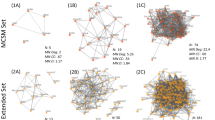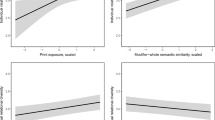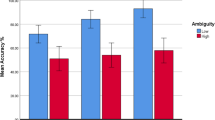Abstract
The ability to correctly learn to interpret and produce novel noun-noun compounds such as wind farm or carbon tax is an important part of the acquisition of language in various domains of discourse. One approach to the interpretation of noun-noun compounds assumes that people make use of distributional information about the linguistic behaviour of words and how they tend to combine in noun-noun phrases; another assumes that people activate and integrate information about the two constituent concepts’ features to produce interpretations. We present a series of experiments that examine how people acquire both the distributional information and conceptual information that is relevant to compound interpretation. We propose that the relations used to link the two words in noun-noun compounds have rich semantic structure, which includes information about what features of concepts are necessary and/or characteristic for particular relations, as well as distributional information about the frequency with which relations co-occur with different concepts. We present an exemplar-based model of the semantics of relations which captures both of these aspects of relation meaning, and show how it can predict experimental participants’ interpretations of novel noun-noun compounds.
This research was conducted while the first author was a graduate student at University College Dublin.
Access this chapter
Tax calculation will be finalised at checkout
Purchases are for personal use only
Similar content being viewed by others
Notes
- 1.
There are exceptions where the type of relation differs depending on word order; these tend to be lexicalized compounds, or compounds containing a polysemous word where the sense in the modifier position can differ from the sense in the head position (e.g. guitar solo and solo guitar).
- 2.
- 3.
If a participant rates two or more relations with the same maximal likelihood, we assume the participant would select at random between them. Whether or not the data are actually transformed in this way makes only small differences to the fit of the model reported subsequently.
- 4.
For example, the relation vector for exemplars occurring with Relation 1 (i.e. the beetle and plant exemplars in items 1, 2, 3, 5, 6 and 7) would be \(\left [1, 0, 0\right ]\).
References
Clark, E. V., & Barron, B. J. (1988). A thrower-button or a button-thrower? Children’s judgments of grammatical and ungrammatical compound nouns. Linguistics, 26, 3–19.
Cannon, G. H. (1987). Historical change and English word formation. New York: Lang.
Devereux, B., & Costello, F. J. (2006). Modelling the interpretation and interpretation ease of noun-noun compounds using a relation space approach to compound meaning. In R. Sun & N. Miyake (Eds.), Proceedings of the Twenty-Eigth Annual Conference of the Cognitive Science Society (pp. 184–189). Mahwah: Cognitive Science Society/Lawrence Erlbaum. ISBN 0-9768318-2-1.
Levi, J. N. (1978). The syntax and semantics of complex nominals. New York: Academic.
Downing, P. (1977). On the creation and use of English compound nouns. Language, 53(4), 810–842.
Gagné, C. L., & Shoben, E. J. (1997). Influence of thematic relations on the comprehension of modifier-noun combinations. Journal of Experimental Psychology: Learning, Memory, and Cognition, 23, 71–78.
Kim, S. N., & Baldwin, T. (2005). Automatic interpretation of noun compounds using WordNet similarity. In Proceedings of the 2nd International Joint Conference on Natural Language Processing. Sydney: Association for Computational Linguistics.
Barr, R. A., & Caplan, L. J. (1987). Category representations and their implications for category structure. Memory and Cognition, 15, 397–418.
Anggoro, F., Gentner, D., & Klibanoff, R. (2005). How to go from nest to home: Children’s learning of relational categories. In B. G. Bara, L. Barsalou, & M. Bucciarelli (Eds.), Proceedings of the Twenty-Seventh Annual Conference of the Cognitive Science Society (pp. 133–138). Mahwah: Cognitive Science Society/Lawrence Erlbaum. ISBN 0-9768318-1-3.
Wisniewski, E. J. (1997). When concepts combine. Psychonomic Bulletin & Review, 4, 167–183.
Costello, F. J. & Keane, M. T. (2000). Efficient creativity: Constraint-guided conceptual combination. Cognitive Science, 24(2), 299–349.
Wisniewski, E. J., & Murphy, G. L. (2005). Frequency of relation type as a determinant of conceptual combination: A reanalysis. Journal of Experimental Psychology: Learning Memory and Cognition, 31, 169–174.
Gagné, C. L., & Spalding, T. L. (2006). Relation availability was not confounded with familiarity or plausibility in gagné and shoben (1997): Comment on wisniewski and murphy (2005). Journal of experimental psychology. Learning, memory, and cognition, 32(6), 1431–1437; discussion 1438–1442. ISSN 02787393.
Tyler, L. K., Moss, H. E., Durrant-Peatfield, M. R., & Levy, J. P. (2000). Conceptual structure and the structure of concepts: A distributed account of category-specific deficits. Brain and Language, 75(2), 195–231.
Tyler, L. K., & Moss, H. E. (2001). Towards a distributed account of conceptual knowledge. Trends in Cognitive Sciences, 5(6), 244–252.
Pexman, P. M., Lupker, S. J., & Hino, Y. (2002). The impact of feedback semantics in visual word recognition: Number-of-features effects in lexical decision and naming tasks. Psychonomic Bulletin & Review, 9, 542–549.
Pexman, P. M., Holyk, G. G., & Monfils, M. -H. (2003). Number-of-features effects and semantic processing. Memory & Cognition, 31, 842–855.
Kounios, J., Green, D. L., Payne, L., Fleck, J. I., Grondin, R., & McRae, K. (2009). Semantic richness and the activation of concepts in semantic memory: Evidence from event-related potentials. Brain Research, 1282, 95–102. ISSN 1872-6240.
Medin, D. L., & Schaffer, M. M. (1978). Context theory of classification learning. Psychological Review, 85, 207–238.
Nosofsky, R. M. (1984). Choice, similarity, and the context theory of classification. Journal of Experimental Psychology: Learning, Memory, and Cognition, 10, 104–114.
Nosofsky, R. M. (1986). Attention, similarity, and the identification-categorization relationship. Journal of Experimental Psychology: General, 115, 39–57.
Nosofsky, R. M. (1987). Attention and learning processes in the identification and categorization of integral stimuli. Journal of Experimental Psychology: Learning, Memory, and Cognition, 13, 87–108.
Gentner, D. (1981). Verb semantic structures in memory for sentences: Evidence for componential representation. Cognitive Psychology, 13, 56–83.
Duncker, K. (1945). On problem solving (L. S. Lees, Trans.). Psychological Monographs, 58(5, Whole No. 270), 1–113.
Keane, M. T. (1985). Ton drawing analogies when solving problems. British Journal of Psychology, 76, 449–458.
Costello, F. J. (2000). An exemplar model of classification in simple and combined categories. In L. R. Gleitman & J. K. Joshi (Eds.), Proceedings of the Twenty-Second Annual Conference of the Cognitive Science Society. Mahwah: Lawrence Erlbaum Associates.
Smith, J. D., & Minda, J. P. (2000). Thirty categorization results in search of a model. Journal Of Experimental Psychology: Learning Memory And Cognition, 26, 3–27.
Costello, F. J. (2001). A computational model of categorisation and category combination: Identifying diseases and new disease combinations. In J. D. Moore & K. Stenning, (Eds.), Proceedings of the Twenty-Third Annual Conference of the Cognitive Science Society, University of Edinburgh (pp. 238–243). Mahwah: Lawrence Erlbaum Associates.
Nosofsky, R. M., & Zaki, S. R. (2002). Exemplar and prototype models revisited: Response strategies, selective attention, and stimulus generalization. Journal of Experimental Psychology: Learning, Memory, and Cognition, 28, 924–940.
Zaki, S. R., Nosofsky, R. M., Stanton, R. D., & Cohen, A. L. (2003). Prototype and exemplar accounts of category learning and attentional allocation: A reassessment. Learning and Memory, 29, 1160–1173.
Yamauchi, T., & Markman, A. B. (2000). Learning categories composed of varying instances: The effect of classification, inference, and structural alignment. Memory & Cognition, 28 64–78.
Yamauchi, T., & Yu, N.-Y. (2008). Category labels versus feature labels: Category labels polarize inferential predictions. Memory & Cognition, 36, 544–553.
Daelemans, W., Zavrel, J., van der Sloot, K., & van den Bosch, A. (2004). TiMBL: Tilburg memory based learner, Version 5.1, Reference guide, Tilburg University (ILK Techn. Rep. 04–02).
Shepard, R. N. (1987). Towards a universal law of generalization for psychological science. Science, 237, 1317–1323.
Nosofsky, R. M. (1985). Overall similarity and the identifcation of separable-dimension stimuli: A choice model analysis. Perception and Psychophysics, 38, 415–432.
Nosofsky, R. M. (1988). Exemplar-based accounts of relations between classiffication, recognition, and typicality. Journal of Experimental Psychology: Learning, Memory, and Cognition, 14, 700–708.
Keselman, H. J. (1998). Testing treatment effects in repeated measures designs: An update for psychophysiological researchers. Psychophysiology, 35, 470–478.
Boik, R. J. (1987). The analysis of two-factor interactions in fixed effects linear models. Journal of Educational Statistics, 18, 1–40.
Devereux, B., & Costello, F. J. (2005). Representing and modelling the meaning of noun-noun compounds. In K. Opwis & I. Penner (Eds.), Proceedings of KogWis05: the Seventh Biannual Meeting of the German Cognitive Science Society (pp. 33–38). Basel: German Cognitive Science Society/Schwabe. ISBN ISBN 0-9768318-1-3.
Devereux, B. (2007). The Role of Relational and Conceptual Knowledge in the Interpretation of Noun-Noun Compounds. Ph.D. thesis, University College Dublin.
Seco, N., Veale, T., & Hayes, J. (2004). An intrinsic information content metric for semantic similarity in wordnet. In Proceedings of ECAI 2004, the 16th European Conference on Artificial Intelligence, (pp. 1089–1090). Valencia: IOS Press.
Gagné, C. L., & Spalding, T. L. (2009). Constituent integration during the processing of compound words: Does it involve the use of relational structures? Journal of Memory and Language, 60, 20–35.
Estes, Z., & Jones, L. L. (2006). Priming via relational similarity: A copper horse is faster when seen through a glass eye. Journal of Memory and Language, 55, 89–101.
Acknowledgements
This research was funded by Irish Research Council for Science, Engineering and Technology Grant RS/2002/758-2 to BD.
Author information
Authors and Affiliations
Corresponding author
Editor information
Editors and Affiliations
Rights and permissions
Copyright information
© 2012 Springer-Verlag Berlin Heidelberg
About this chapter
Cite this chapter
Devereux, B.J., Costello, F.J. (2012). Learning to Interpret Novel Noun-Noun Compounds: Evidence from Category Learning Experiments. In: Villavicencio, A., Poibeau, T., Korhonen, A., Alishahi, A. (eds) Cognitive Aspects of Computational Language Acquisition. Theory and Applications of Natural Language Processing. Springer, Berlin, Heidelberg. https://doi.org/10.1007/978-3-642-31863-4_8
Download citation
DOI: https://doi.org/10.1007/978-3-642-31863-4_8
Published:
Publisher Name: Springer, Berlin, Heidelberg
Print ISBN: 978-3-642-31862-7
Online ISBN: 978-3-642-31863-4
eBook Packages: Computer ScienceComputer Science (R0)




